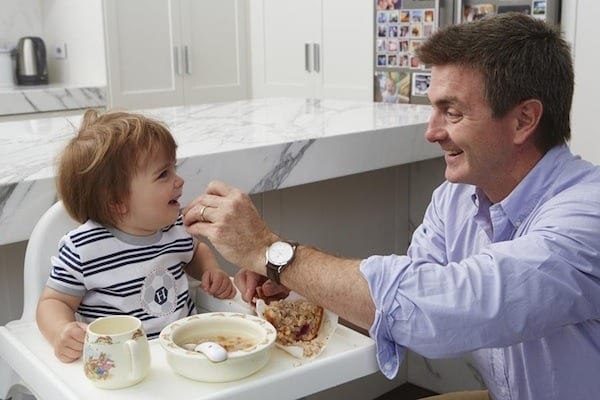Just 4.6% of two-parent families with kids under 15 have stay-at-home dads. That’s only a slight increase of 80,000 in 2016, up from 68,500 in 2011 (4.2%), according to a new report from the Australian Institute of Family Studies based on 2016 Census data.
And that’s compared to the 498,900 families that have stay-at-home mothers.
Stay-at-home parents are defined as mother or fathers who’re not employed, but have a partner who is working out of the home.
According to the report author Jennifer Baxter, the analysis shows that this group of 80,000 fathers is very diverse, and many of them may not identify with the ‘stay-at-home’ dad role. They may better identify as being unemployed, or as students.
So why is it still so rare for men to take on this role, and identify with it?
This morning I put the question to Prue Gilbert, a former human rights lawyer who is now the founder and CEO of Grace Papers, a digital platform and consultancy working with mums and dads and workplaces to challenge gendered expectations at work a in the home.
Prue’s own family has bucked the trend of most similar households. Starting her business when she had three kids under five, Prue’s husband Ben (pictured above) took a lengthy stint of parental leave, before later working for Prue on Grace Papers. Ben wrote about becoming ‘Chief Parenting Officer’ on Women’s Agenda in 2016.
Prue questions whether many couples are making subconscious decisions based on short-term outcomes when it comes to deciding who will stay home with the kids, and/or will take a step back from their career
One such decision might come down to who is earning more at the time, something that will statistically favour a father to continue on in his career over a mother. Prue notes the age gap in first time mothers and fathers — which gives fathers a couple of years advantage on leadership and earnings potential, on top of the existing gender pay gap. “Couples tend to make decisions about career and care based on their current circumstances, rather than their potential,” says Prue.
She believes there are other subconscious factors at play, including that many couples still think of childcare as a ‘mothers cost’ alone, rather than a family cost. Prue also points to data that finds many women don’t believe bias and discrimination is going to affect their careers — often only until it well and truly has. “We weren’t prepared for there to still be gender inequality,” Prue says on gradating from law and starting her career in the profession. You can look at some of former prime minister Julia Gillard’s comments from earlier this week to see that she too wasn’t prepared for it.
Prue believes that although she and her husband worked flexibly while building Grace Papers, Ben was the primary carer during this time — which help her push the business forward.
“It meant that I could travel whenever I needed to without having to consult with him,” she says. “We both had this acknowledgment that we were focusing on the growth of Grace Papers as the priority, but not at the cost of either of our professional or personal goals.”
She adds that Ben doesn’t feel like the experience has impacted his career. If anything, it’s made him a better leader, and positioned him well in order to recently become the CEO of another business — three years since he started working flexibly on Grace Papers. The change means the couple is now negotiating their time and priorities, especially around school holidays. They discuss their upcoming commitments via weekly and monthly meetings and are both careful to remember that no current arrangement is forever.
Writing about why we’re not seeing more fathers becoming stay at home parents in 2018, Jennifer Baxter says there are numerous factors making such an arrangement unworkable for many families, including the financial constraints of families needing two incomes. However, like Prue, she also believes gender-based parenting attitudes are likely to play a part.


